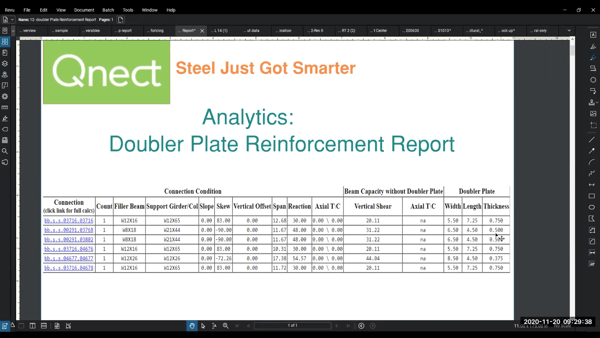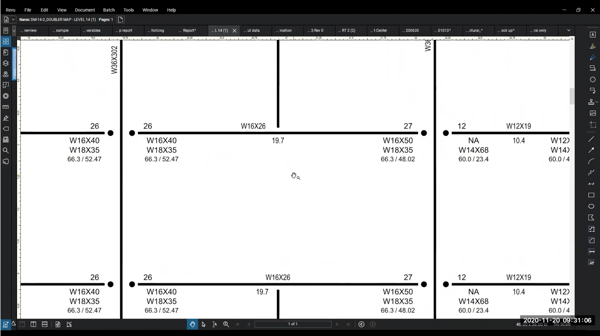Eliminate beam web doubler reinforcing efficiently and effectively
(The content below is the transcript from the video.)
We're extremely excited today to walk you through this process of upsizing beams to eliminate beam web doubler reinforcing. So you have beam web reinforcing double plates on your job. What should you do and how can you get rid of them? Let us show you how to communicate with an EOR with data that is sure to get you what you need.
Now, the very first thing that Qnect does - and again even during estimating or in production - is to provide a double plate reinforcing report. How many of you may have seen already this the report?
The report, while it shows the double plate reinforcing data, which we will certainly provide, it shows you two other things.

Clearly you have basically two choices or three choices:
It certainly doesn't take a lot of imagination to see, to think about, an 818 going into a 10 15 or 12 14. But as you all know, most jobs don't have the time to go through this process except with Qnect you have the time, the space to think, to plan, to ask all within a time frame that keeps the job very much on schedule.
Let me show you a profound way that we have come up with to support this elimination. This is our double plate map.

This is a map of a flaw on a job and we're showing several things on this map. Now this map can be used as a RFI - Request For Information - that you would send to the EOR for approval.
On that RFI we would note the following. First, is the 16 inch by 26 beam that needs reinforcing. Then on the map we will show you what the demand of the beam is. In this case it's a 66.3 KIP load based on UDL and what the beam is able to carry prior to reinforcing.
The first question on the RFI is “mr. or mrs. engineer can we lower the load to 52.47 kips to eliminate the reinforcing?” If that's not possible, Qnect has provided the upsize beams that would eliminate the reinforcing plate or the original demand load of 66.3.
We provide two beam sizes.
First, the beam size of the same depth upside so 16X26 to 16X40 and a second beam size of the next depth category that would accomplish the elimination. In this case, you can see that 18X35 and interestingly enough that one actually is less weight given up and becomes an interesting and better opportunity from a cost standpoint.
Here's another case on a 12 inch beam - for example a 60 KIP command it can only take 23.4 on this end; on this end not a problem it can take as much as 47.83 when we tried every 12 inch imaginable. We just couldn't get it to work because this beam is too large and it's causing um 36X395 we just can't get it to work. So if they want to upsize it they need to go to a 14X68 to get the 60 KIPs satisfied.
So with this map the EOR is now able to examine it and decide and offer the possibilities.
Again the key here is identifying the problem early, communicating it in a proper way for everyone to be able to understand it, and to work through it efficiently and effectively. Qnect is able to do this in the manner we've shown you
Check out this short video showing a high-level demonstration of Qnect's vertical bracing. Josh will walk you through the preference settings, using Button 1 and Button 2. Then register for the webinar below to get a more in-depth review.
Qnect provides innovative software and services that reduce waste, lower carbon emissions, and maximize time and cost efficiency for the steel construction industry. Our goal is to deliver innovative and sustainable solutions for the construction industry to build a better future.
[fa icon="phone"] (413) 387-4375
[fa icon="envelope"] Marketing@Qnect.com
[fa icon="home"] 245 Russell St., Hadley MA